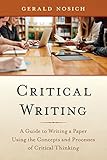Critical writing : a guide to writing a paper using the concepts and processes of critical thinking / Gerald Nosich
By: Nosich, Gerald M [author.].
Publisher: Lanham : Rowman & Littlefield, ©2022Description: 257 p: illustrations (black and white) ; 24 cm.Content type: text Media type: unmediated Carrier type: volumeISBN: 9781538140901; 153814090X; 9781538140918; 1538140918.Subject(s): Academic writing -- Study and teaching (Higher) | Critical thinking -- Study and teaching | Creative writingGenre/Form: Print books.| Current location | Call number | Status | Date due | Barcode | Item holds |
|---|---|---|---|---|---|
| On Shelf | LB2369 .N68 2022 (Browse shelf) | Available | AU00000000017802 |
Includes practice and self-assessment exercises and self-assessment tests
Includes bibliographical references (pages 243-244) and index
Brief overview -- To the instructor -- A framework for critical writing -- Main features of the book -- To the student: Before you begin -- Test it out -- A few things to keep in mind as you work through this book -- Chapter 1: Thinking about writing -- Chapter 2: Beginning the paper: The elements of reasoning -- Chapter 3: Constructing the paper: Planning, researching, writing -- Chapter 4: Other minds, other views: Addressing "the Other Side" and cultivating critical thinking traits of mind -- Chapter 5: Making the paper better: Critical thinking standards and Socratic questioning -- Chapter 6: Making it flow, making it complete: Content, audience, communication, and criticality -- Responses to starred practice and assessment exercises
"The main goal of this book is to provide students with a set of robust, integrated critical concepts and processes that will allow to them think through a topic and then write about it, and to do so in a way that is built on, and permeated by, substantive critical thinking"--
This step-by-step guide shows: how to construct a thesis statement and the other main points that constitute the structure of the paper ; how to write the paragraphs that make up the body of the paper ; how to engage in productive research in a planned, self-directed way ; how to make a point clear -- not just grammatically or stylistically but also how to clearly convey ideas to an audience ; how to think your way through the numerous unanticipated issues (including aspects of grammatical correctness, transitions, and many others) that arise while writing papers. Each step provides close and careful processes for carrying out each of these tasks, through the use of critical thinking. -- Provided by publisher


